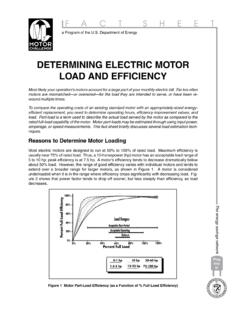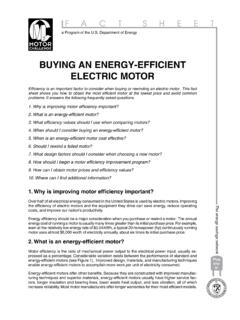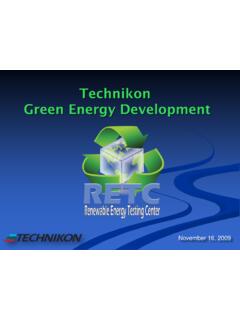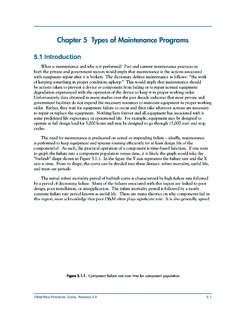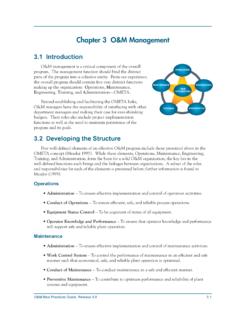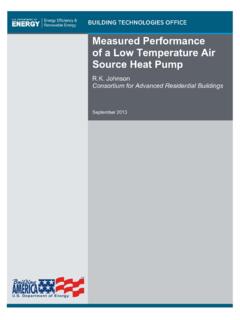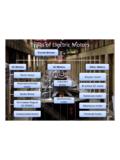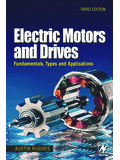Transcription of Improving Motor and Drive System Performance
1 Industrial Technologies ProgramImproving Motor and Drive System Performance : A Sourcebook for IndustryAcknowledgementsImproving Motor and Drive System Performance : A Sourcebook for Industry was developed for the Department of Energy s (DOE) Industrial Technologies Program (ITP). This project is one in a series of sourcebooks on industri-al systems. Other publications in this series cover fan, compressed air, process heating, pumping, and steam systems. For more information about DOE and ITP, please see Section 4, Where to Find Help. This sourcebook was prepared for ITP by technical staff at Lawrence Berkeley National Laboratory and Resource Dynamics Corporation. They wish to thank the many organizations that so generously assisted in data collection and to acknowledge the helpful reviews and other contributions provided by the following individuals:Dale Basso, Rockwell AutomationThomas Bishop, Electrical Apparatus Service AssociationAustin Bonnett, Electrical Apparatus Service Association Rob Boteler, Electrical MotorsDennis Bowns, Bowns & Casada, Diagnostic SolutionsJasper Fischer, Industrial Motor RepairJohn Kueck, Oak Ridge National LaboratoryJohn Machelor, Motor -Vations, LLC John Malinowski, Baldor electric Mason, Consortium for Energy EfficiencyGil McCoy, Washington State Energy OfficeSally McInerney, University of AlabamaCynthia Nyberg, Electrical Apparatus Service AssociationHoward W.
2 Penrose, , SUCCESS by Design Reliability ServicesCharles Straub, , Marathon ElectricEdward J. Swann, Rockwell AutomationJohn Tolbert, Bristol CompressorChuck Yung, Electrical Apparatus Service AssociationSeptember 2008 Prepared for the Department of EnergyOffice of Energy Efficiency and Renewable EnergyIndustrial Technologies ProgramBy Lawrence Berkeley National LaboratoryBerkeley, CaliforniaResource Dynamics CorporationMcLean, VirginiaProduced by the National Renewable Energy LaboratoryGolden, ColoradoTable of Contents Acknowledgements iQuick Start Guide 1 Section 1: Motor and Drive System Basics 3 Overview 3 A System Approach 3 Indications of Poor System Design 4 Types of electric Motors 4 Motor Operating Characteristics 8 Load Characteristics 10 Matching motors and drives to Their Applications 11 Load Duty Cycles 14 Common Motor Selection Problems 15 Summary 16 Section 2: Performance Opportunity Roadmap 17 Overview 17 Efficiency Opportunities 17 Section 3: Motor System Economics 39 Overview 39 Understanding Corporate Policies 39 Measuring the Dollar Impact of Efficiency 39 Presenting the Finances of Efficiency 40 Relating Efficiency to Corporate Priorities 40 Summary 44 Section 4.
3 Where to Find Help 45 Directory of Contacts 49 Resources and Tools 50 Training Courses 60 Appendices 61 Appendix A: Glossary of Basic Motor System Terms 63 Appendix B: Motor Tip Sheets 67 Appendix C: EPAct Efficiency Levels and Premium Efficiency Levels 99 Appendix D: Motor Repair Service Center Checklist 105 Appendix E: Guidelines for Comments 111 Continued >List of Figures Figure 1. 4 Figure 2. 6 Figure 3. 6 Figure 4. 8 Figure 5. 10 Figure 6. 11 Figure 7. 11 Figure 8. 12 Figure 9. 13 Figure 10. 15 Figure 11. 15 Figure 12. 18 Figure 13. 26 Figure 14. 27 Figure 15. 27 Figure 16. 34 Figure 17. 45 Figure 18. 46 List of Tables Table 1. 23 Table 2. 27 Table 3. 29 Table 4. 43 Quick Start GuideThis sourcebook is designed to provide those who use Motor and Drive systems with a reference that outlines opportunities to improve System Performance .
4 It is not meant to be a comprehensive technical text on Motor and Drive systems; rather, it provides practical guidelines and information to make readers aware of potential Performance improvements. Guidance on how to find more information and assistance is also included. Plant engineers, facility managers, operations personnel, and others whose work involves Motor and Drive systems will find this sourcebook helpful in assessing the efficiency of their Motor and Drive applications. Discussions of improvement opportunities in this sourcebook emphasize the connection between operating efficiency and System reliability. For example, a plant project that increases the overall efficiency of a Motor and Drive System often reduces plant downtime, as well. This is one of several important benefits of efficiency improvements.
5 This sourcebook is divided into four main sections, as outlined Section 1: Motor and Drive System Basics For readers who are unfamiliar with the basics of Motor and Drive systems or would like a refresher, this section briefly describes important terms, relationships, and System design considerations. It also describes key factors involved in Motor and Drive selection and System design, and provides an overview of the different types of motors and drives and their applications. Readers who are already familiar with key terms and parameters used in selecting motors and drives , designing systems, and controlling their operation might want to skip this section and go on to the next one. n Section 2: Performance Opportunity Roadmap This section describes the key components of a Motor and Drive System as well as opportunities for Performance improvements.
6 A systems approach is emphasized, rather than a focus on individual components. Guidance is provided in a set of efficiency opportunities, which cover the following topics in separate subsections for easy reference: Assessing Motor and Drive System Operating Conditions Establishing a Motor Management Program Providing Basic Maintenance Selecting the Right Motor Using Variable Frequency Drives Addressing In-Plant Electrical Distribution and Power Quality Issues Using the Service Center Evaluation Guiden Section 3: Motor System Economics This section provides recommendations on how to propose projects like those described in Section 2 by highlighting for management the favorable economics of Motor and Drive System improvements. Topics include understanding and identifying corporate priorities, relating those priorities to efficiency, and clarifying the financial aspects of efficiency improvements, including life-cycle costs and payback Section 4: Where to Find Help Section 4 provides a directory of associations and other organizations associated with motors and drives and their markets.
7 This section also lists helpful resources for more information, tools, software, videos, and training opportunities. Quick Start GuideImproving Motor and Drive System Performance : A Sourcebook for Industry1n AppendicesThis sourcebook contains five appendices: Appendix A is a glossary of terms used in discussing Motor and Drive systems; these terms appear in bold type when they are first mentioned in the text. Appendix B contains a series of Motor and Drive System tip sheets. Developed by the Department of Energy (DOE), these tip sheets discuss opportunities for Improving the efficiency and Performance of Motor systems, but in less detail than the efficiency opportunities described in Section 2. Appendix C provides Energy Policy Act (EPAct) efficiency levels for motors up to 200 horsepower (hp) in size, along with National Electrical Manufacturers Association (NEMA) Premium Motor efficiency levels.
8 Appendix D includes a checklist for Motor repair facilities. Appendix E provides guidelines for submitting suggested changes and improvements to the 1: Motor and Drive System BasicsImproving Motor and Drive System Performance : A Sourcebook for Industry3 Section 1: Motor and Drive System Basics OverviewElectric motors, taken together, make up the single largest end use of electricity in the United States. In industrial applications, electric motors account for roughly 60% of electricity consumption; in the process industries, electric motors account for more than 70% of electricity use. electric motors provide efficient, reliable, long-lasting service, and most require comparatively little maintenance. Despite these advantages, however, they can be inefficient and costly to operate if they are not properly selected and maintained.
9 Industrial plants can avoid unnecessary increases in energy consumption, maintenance, and costs, by selecting motors that are well suited to their applications and making sure that they are well maintained. A System Approach Cost-effective operation and maintenance of a Motor and Drive System requires attention not just to individual pieces of equipment but to the System as a whole. A systems approach analyzes both the supply and demand sides of the System and how they interact, essentially shifting the focus from individual components to total System Performance . Operators can sometimes be so focused on the immediate demands of their equipment that they overlook the ways in which the System s parameters are affecting that equipment. A common engineering approach is to break a System down into its basic components or modules, optimize the selection or design of those components, and then assemble the System .
10 An advantage of this approach is that it simplifies problems. A disadvantage is that this approach ignores the interaction of the components. For example, sizing a Motor so that it is larger than necessary essentially giving it a safety factor ensures that the Motor is strong enough to meet the needs of the application. However, an oversized Motor can create Performance problems with the driven equipment, especially in turbomachinery such as fans or pumps. In certain circumstances, an oversized Motor can compromise the reliability of both the components and the entire System . In a component approach, the engineer employs a particular design condition to specify a component. In a systems approach, the engineer evaluates the entire System to determine how end-use requirements can be provided most effectively and efficiently.
